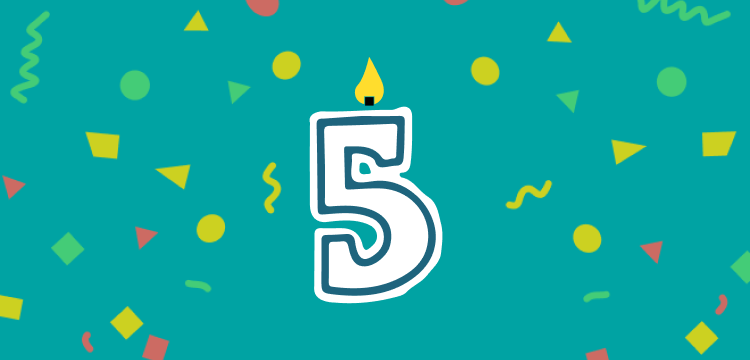Your 5-Month-Old Baby's Development and Milestones
The months have flown by, and your baby has been growing rapidly—at 5 months old they may be twice as big as they were at birth. It’s not just their little body that is growing, but their whole world, too. They may show an interest in complex shapes and patterns, and perhaps even try to babble to you in their early attempts at conversation. Enjoy the ride as you watch your little one grow and develop this month and read on to see what exciting things your baby will learn to do!
Baby Development Milestones
Let’s see what exciting and sometimes challenging changes await you and your baby this month.
Growth and Physical Development: Twice the Size
Each baby is different and will develop at their own pace, but once your baby turns about 5 months old, you may notice that they’re about double their birth weight. On average, babies this age will gain around 1 1/4 pounds and grow 0.8 inches in length per month. Your baby’s healthcare provider will use baby growth charts to make sure your baby's growth is steady and on track.
Senses: Your Baby Loves Red and Blue
Your baby’s eyesight keeps on improving. So, how far can a 5-month-old see? By now they can see much farther than before—think yards. You might notice reds and blues are their favorites as they may prefer to look at those colors. Your little one will likely enjoy staring at more complex patterns and shapes; they will find these interesting as their sight matures, so don’t shy away from showing them picture books and posters with bold and intricate patterns.
Movement: Building Stronger Core Muscles
Your baby is getting stronger, and they’re working on building those all-important core muscles. By now, they can raise and hold their head and chest when lying on their stomach. They’ll continue to strengthen these muscles as they push their head and chest further up. Perhaps they’ll enthusiastically move their legs and rock back and forth on their tummy. This developmental milestone isn’t just your 5-month-old baby being cute—it’s how they’re building the strength to eventually roll over and to start crawling.
Personality: Your Baby Gets Experimental
Babies are fast learners, and each experience will teach your little one so many things. At around 5 months old, your baby will start to learn that each action has a reaction. Perhaps they will kick their mattress and notice the crib rocks, or they’ll drop something and see that you pick it up. This will encourage them to become curious and they will test out how they can influence the world around them.
This “experimentation” may get frustrating for you as a parent—it’s not fun to pick up a dropped rattle for the umpteenth time—but indulge them so long as it’s safe. Make sure they don’t play with anything they can choke on, or that’s breakable, sharp, or toxic. Experimenting helps their brain develop and will also help them better understand how they can impact their environment.
As your 5-month-old baby’s intellectual development progresses, you’ll be fascinated by their ability to soak up information like a sponge. Engage them by taking them for walks around the neighborhood, talking to them, and showing them new things. They will love looking at books with large, brightly colored pictures.
You can also help your baby develop their language skills by calling out the names of the new things they see. They may even babble back in “baby talk” as if they’ve understood you. When you talk to them, pause for a second to let them give you an “answer.” These are your first conversations together, and although your little one may not make much sense at 5 months old, isn’t it lovely to communicate with your baby? The more you do it, the better they become, and they’ll be ready to say their first words in a few months’ time.
Activities for Supporting Your 5-Month-Old Baby's Development
Your baby has been working hard to develop strong neck and shoulder muscles. Over the coming months, they will use these muscles to stay sitting up, roll over, crawl, and eventually walk. So, what “should” a 5-month-old be doing this month? Continue with providing daily tummy time sessions two or three times a day to help your little one build these skills. As your baby gets used to tummy time, you can do it more often to help them gain strength and confidence. Make sure they’re awake during tummy time and never leave them unattended.
Feeding Your 5-Month-Old Baby
You may have a list of questions this month when it comes to your baby’s eating/feeding schedule, such as: How much “should” a 5-month-old eat? How many ounces “should” a 5-month-old eat or drink? In general, at 5 months old, your baby may be taking in four to six ounces of breast milk or formula at each feeding, or perhaps even more.
Your baby may need to eat more when they go through a growth spurt, which can happen at any time after 5 months old but more likely when your baby turns about 6 months old. So, how often “should” a 5-month-old eat? Whenever they seem hungry. Follow their hunger cues and feed them on demand.
Wondering what can a 5-month-old eat besides breast milk or formula? Experts recommend that between 4 and 6 months of age is the right time to start introducing solid foods into your baby’s feeding schedule. That’s around the time your baby starts losing the tongue-thrust reflex, which is what helps them breast- or bottle-feed.
Traditionally, single grain infant cereals have been among the first foods to be offered but you could also begin with pureed vegetables and fruits. Wondering how much to give your baby? Start with a few spoonfuls and gauge your baby’s reaction. You may need to go back to breast- or bottle-feeding. Consult your baby’s healthcare provider before starting your baby on solid foods.
What goes hand in hand with feeding? Diaper changes! Although diaper changes may not be exciting, they can be rewarding! Download the Pampers Club app and turn diapers and wipes into rewards.
A 5-Month-Old’s Sleep Schedule: How Much Sleep Does Your Baby Need?
Wondering about your 5-month-old’s nap/sleep schedule and how much sleep they “should” get or need? Around this time your baby will sleep 12 to 16 hours a day. This includes an extended stretch at night with perhaps only a few brief awakenings. Each baby is different but with any luck, they won’t need feeding in the middle of the night by this age. Five-month-old babies still need a couple of naps and will sleep around three to four hours during the day.
If your baby’s struggling with sleep, check out the Smart Sleep Coach app by Pampers. Cocreated by pediatricians and sleep experts, this easy-to-use app features a sleep tracker that automatically recommends bedtimes and advice to help you navigate your baby’s sleep challenges.
A Day in the Life of Your 5-Month-Old Baby
By now you may have settled into a routine that works well for you and your baby, but in case you’re still wondering what things to do with a 5-month-old baby all day, here’s an example of how your baby’s daily schedule may pan out on any average day:
Your Baby’s Health
It’s upsetting to see your baby unwell or hear them cry when they feel pain or discomfort. You try everything as a parent to make sure your little one is safe and healthy, but there are times when they feel ill, no matter how careful you are. Some common health concerns that may affect a 5-month-old baby include:
Teething. You may notice your baby is drooling, cranky, or crying from discomfort this month. Between 4 and 7 months old, many babies start to get their first teeth. Your baby may get lucky and not feel any pain when they’re teething, but they may still have swollen or tender gums. Ease their discomfort when teething by giving them a teething ring made of firm rubber or rubbing their gums with a clean finger. If you notice they’re drooling, just wipe their mouth with a clean cloth to prevent a teething rash.
Conjunctivitis. This is when the white of the eye and the inside of the lower eyelid become red and inflamed. Also known as pinkeye, conjunctivitis is itchy and painful, and tends to last a week or two. Conjunctivitis is usually caused by an infection but can also be provoked by an allergy or an irritation to something like smoke. Take your baby to their healthcare provider if you think they may have an eye infection because treatment will likely be required. Conjunctivitis is very contagious, so wash your hands before and after administering any eye drops. If your baby is in child care it may be best to keep them at home until they’re better.
Development Tips for Your Baby This Month
Here are some ways to encourage your 5-month-old baby’s development:
Play with your baby every day. Wondering how to play with a 5-month-old? It’s simple: Make faces, make sounds, play peekaboo, or hold up toys or interesting objects. You can play with your little one on the floor and incorporate tummy time, and you can also play while you're changing their diaper, bathing them, or strolling in the neighborhood
Talk with your baby. If your baby babbles, mimic them—they may even mimic your words. Talk or sing to them. Narrate what you’re doing. All these actions are how they learn language.
Read to your baby. Daily reading entertains your little one and also helps with their visual, cognitive, and language development. These moments are also important in strengthening the parent-child bond.
Introduce your baby to people. Let your baby meet other parents and their babies. But watch your baby’s cues in case they’re overstimulated and aren’t ready to meet new people just yet.
Give your baby toys to play with. Your 5-month-old baby will enjoy toys that can make sounds and those with interesting textures.
Items You Will Need This Month
Here’s a list of baby gear that you might like to buy this month, if you haven’t already:
Teething rings. Your little one may start sprouting teeth around 5 months old, although the timing varies from baby to baby. Be prepared by purchasing a few teethers for them to chew on. These should be made of firm rubber. Avoid necklaces and teethers that are attached to strings or plush toys, as these can become a safety hazard.
Play mat or activity gym. Make tummy time even more enjoyable by using a play mat or activity gym to encourage your little one to reach, swat, and play during their daily tummy time sessions.
Baby books. Unpack those children’s books from your parents’ attic or find some new books at the library or bookstore.
Diapers, wipes, and diaper rash cream. Stock up on those diapers and wipes (and diaper rash cream), because you can never have enough.
Child-proof cabinet locks. Before your baby begins crawling, it’s a good idea to start babyproofing your home, which means gathering cabinet locks, outlet covers, and other items you’d need to make your home safer for your little adventurer.
Baby gates. You'll want to place these at the top and bottom of any stairs in your home. A baby gate can also serve to block off a room that you want to keep off limits for an active crawler or walker.
Your Life as a Parent: Body Image and Self-Care
Now that a few months have passed since the birth of your baby and you’re settling into a routine, you may be starting to think more about yourself. Good for you! Taking care of yourself is important, and as a new parent, it can be easy to overlook your own needs. You can get started by adding healthier habits to your daily routine.
As the mom, you may be quite eager to return to your prepregnancy figure, but it does take some time to achieve healthy weight loss after having a baby. The key is slow and steady. Remind yourself that although your body may not look like it used to, it has done something truly incredible by giving birth to a new life. Look at how strong you are! Here are some ideas to help you feel good, or even great, about where you are right now:
Healthy eating. Eat more fiber-filled fruits, vegetables, and whole grains; add proteins like chicken, eggs, or fish to meals; limit desserts and treats like chocolate, chips, ice cream, candies, and cookies; and watch your portion sizes.
Exercise. Once your healthcare provider gives you the all-clear, add some gentle exercise back into your daily routine. You’ll have to slowly work back toward your prepregnancy fitness levels, so aim to gradually build up your physical strength and endurance over time.
Me-time. It might be challenging to set aside time for yourself, but it’s important to find balance. Make plans to go to the movies with friends, or on a date night with your partner, or indulge in a spa treatment for a little well-deserved “me time.” Don’t be afraid to ask for help: Get your partner, family members, or your babysitter to come to your aid when you’re feeling overwhelmed or just need a break.
Checklist for This Month
Now that your baby is becoming more mobile, take another look at babyproofing your home to make it as safe as possible for an active baby who’s ready to explore and soon crawl. It could help to get on your hands and knees and crawl around your home to see from their eye level what hazards need to be eliminated:
□ Remove or hide any cords or electric cables your baby could become entangled in
□ Secure any heavy objects that could topple over once your baby starts to pull themselves up on them
□ Babyproof edges of furniture like bookshelves and coffee tables
□ If you have stairs, it may be time to install baby gates.
□ Take a moment to look ahead to what could be coming for your little one when they’re 6 months old.
□ Download and print these milestone cards to celebrate and share the news with friends and family when your baby turns 6 months old.
□ For even more information, sign up to get our emails:
How We Wrote This Article The information in this article is based on the expert advice found in trusted medical and government sources, such as the American Academy of Pediatrics and the American College of Obstetricians and Gynecologists. You can find a full list of sources used for this article below. The content on this page should not replace professional medical advice. Always consult medical professionals for full diagnosis and treatment.











